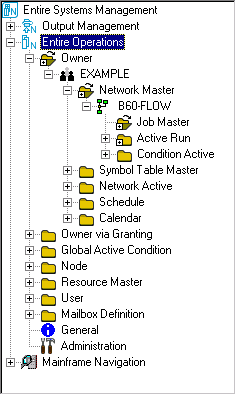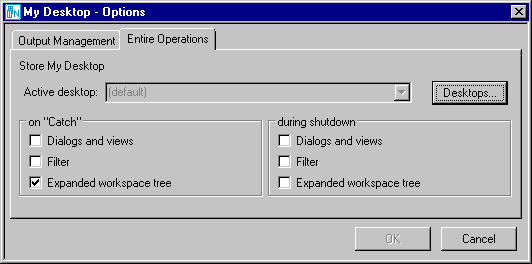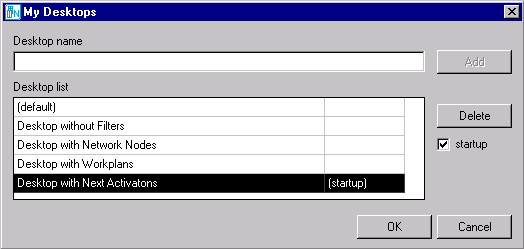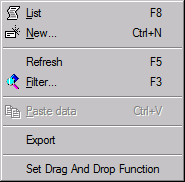When you start the Entire Operations GUI Client, an Entire Systems Management main application window similar to the example below opens:

The main application window contains the
object workspace
with the Entire Operations tree view on the left and the
content pane on the right. To
modify the size of a pane, move the mouse pointer over the border separating
the panes until the pointer changes, showing two arrows pointing in opposite
directions  . Then drag the
border using the mouse until the panes have the required size.
. Then drag the
border using the mouse until the panes have the required size.
In addition to the object workspace and the content pane, the main application window contains the menu bar, the toolbar, the command line, the result list and the status bar.
Note:
You can hide application nodes that cannot be accessed for
different reasons by using the ESUEX01N user exit routine for the System
Automation Tools server. For details, see the source object ZSUEX01N (supplied
for ESUEX01N) in the Natural SYSSAT system library.
This document covers the following topics:
The Entire Operations object workspace with the tree view is on the left side of the main application window:

In the object workspace, all available Entire Operation objects are hierarchically listed as the nodes of a tree view. You can create and maintain objects by using the functions provided by the context menu of a selected node or subnode.
 To show or hide the workspace
To show or hide the workspace
In the View menu, mark or unmark Object Workspace to show (default) or hide the object workspace respectively.
You can expand or collapse a tree node to list and access all objects contained in a node or subnode.
 To expand or collapse a tree node
To expand or collapse a tree node
With the left mouse button, click on the plus or minus sign in front of the node you want to expand or collapse respectively.
An object preceded by a minus sign is fully expanded; an object preceded by a plus sign is fully collapsed.
Or:
Use the Expanded workspace tree option
of the menu item My Desktop >
Options described in My Desktop Menu.
 To navigate within the tree view
To navigate within the tree view
Press UP ARROW or DOWN ARROW to move the selection up or down in the tree view or list view.
Or:
Press LEFT ARROW or RIGHT ARROW to
select or collapse an object in the tree view within the same hierarchy.
Or:
Press ENTER or double-click on an object to
perform the default function for the currently selected object. It also
collapses or selects an object, depending on its current state.
Or:
Press HOME or END to select the
first or the last object within the tree view or list view.
 To add an object
To add an object
Select an object for which the New function is available in the context menu.
Press the INSERT key to trigger the New function.
A Create new window opens where you can enter all definitions required to add a new object.
 To delete an object
To delete an object
If the Delete function exists for the respective object:
Select an object for which the Delete function is available in the context menu.
Press DELETE.
The selected object is deleted.
The menu bar is at the top of the main application window on the left:

This section covers the following topics:
 To choose a menu from the menu bar
To choose a menu from the menu bar
Select the appropriate menu.
A drop-down menu of options appears.
From the drop-down menu, choose the required function and object options.
The following menus are available:
| Menu | Function |
|---|---|
| Object | Filter, list, create, modify, display or perform other functions on the selected objects. Exit the Entire Operations GUI Client. |
| View | Show or hide the object workspace, command line, result list and/or status bar. |
| Options | Select either German or English, modify trace options. Select trace level and trace writing mode (continuous or overwrite), set refresh mode (current level or recursive). See Options Menu for detailed information. |
| My Desktop | Individual desktop settings described in My Desktop Menu. |
| Window | Select the next, previous or required content pane. Close all panes. |
| Help | For a selected Entire Operations node:
Content: Display the main overview of the Entire Operations GUI Client documentation. See also Online Help and System Messages. About Entire Operations: Display the current version of Entire Operations. |
The Options menu provides the following:
- Language
Select the required language:
- Refresh Mode
Set the refresh mode (current level or recursive):
- Trace
Set trace options:
See Tracing for detailed information.
- Grid Lines
Display or hide grid lines for list views.
See also Showing or Hiding Grid Lines.
- Interval Expansion
Applies to Output Management only.
The options and functions provided by the My Desktop menu are used to customize or reset your Entire Operations environment. You can save the setting of the tree view (expanded nodes, set filters) and the windows opened during a session as a default setting for future sessions.
You enable (default) or disable My Desktop customization settings with the Restore My Desktop option in the Software AG ESM Logon dialog at the startup of an Entire Systems Management session (see also Starting and Ending an Entire Operations Session. The Restore My Desktop option retrieves your latest desktop settings from your user profile.
Disabling My Desktop can be useful if customized desktop settings are not required for a session or if the My Desktop startup causes problems.
Note:
The menu items My Desktop >
Catch and My Desktop >
Reset are only enabled when at least one option in the
My Desktop -
Options window is saved in Catch
mode.
This section covers the following topics:
 To customize your desktop
To customize your desktop
Logon with the user ID of the user whose desktop you want to customize. Make sure that the Restore My Desktop option is selected in the Software AG ESM Logon dialog (see Starting and Ending an Entire Operations Session).
From the My Desktop menu, choose Options.
A My Desktop - Options dialog similar to the example below opens:

Choose Desktops if you want to select an alternative desktop (if available) instead of the default desktop indicated by (default) in the Active desktop field. See also Using Alternative Desktops.
Select one or more options in the on "Catch" section if you want to save your desktop settings during the current session.
Or:
Select one or more options in the during shutdown section if you want to save your desktop settings when shutting down Entire Systems Management.
You cannot select the same option in both sections.
Select the settings you want to keep for a future session:
Dialogs and views
Keeps a window open if it contains one of the following:
Object list view, workplan, schedule,
diagram;
Monitor status, node connection status, activity
log, browse log;
List of next activations, network history,
messages;
Import/export queue, report queue.
Filter
Uses all filters set by the user (see also Filtering Objects).
Expanded workspace tree
Keeps tree view nodes expanded in the object workspace.
If required, save your current desktop settings as an alternative desktop: see Using Alternative Desktops.
Choose OK when you are finished.
The desktop settings are stored in the user profile of the current user.
Choose My Desktop > Catch whenever you want to save the current settings during the session.
(If the during shutdown option is used, the settings are automatically saved when the session terminates.)
 To use alternative desktops
To use alternative desktops
In the My Desktop - Options dialog, select the required settings and choose Desktops.
A My Desktops dialog similar to the example below opens:

In the Desktop name field, enter a name of up to 32 alphanumeric characters and choose Add.
The specified name is added to the Desktop list and can be used to save your settings during Catch or shutdown operations.
You can have a maximum of 4 alternative desktops.
To set a default desktop:
From the Desktop list, select the desktop you want to use for future sessions and mark the startup check box. The selected desktop is marked with (startup) in the list.
To delete a desktop:
From the Desktop list, select the desktop you want to remove and choose Delete. The selected desktop is removed from the list.
You cannot delete the (default) desktop.
Choose OK when you are finished.
At the next session start, a dialog similar to the following opens if at least one alternative desktop exists:

The desktop marked with (startup) is entered in the Entire Operations field by default.
If you want to use another desktop for a future session, select the required desktop from the drop-down list box and mark the Save selection as start default. This desktop is then marked with (startup) in the Desktop list and used at the next session start.
Choose OK.
The settings stored last in your user profile are loaded into your Entire Operations environment.
 To reset all or single desktop settings
To reset all or single desktop settings
From the My Desktop menu, choose Reset and one of the following options:
All
Dialogs and views
Filter
Expanded workspace tree
Choose All if you want to reset all desktop settings, or choose the required setting.
A dimmed option indicates that no corresponding desktop setting exists.
The desktop currently active is reset.
The toolbar is just below the menu bar at the top of the screen.

 To perform a function from the toolbar
To perform a function from the toolbar
Choose the appropriate function icon. If an icon is grayed-out, the function is not available for the selected object.
The content pane takes up the right side of the main application window. The appropriate list, window, diagram or dialog appears here, when you perform a function for an object.
The Results window (shown by default) contains a list of messages that report hints, errors and warnings that occur during the session as a result of function processing.

A context menu is available where you can get detailed information for a specific line and can delete one or all messages in the result list.

Click on the button or use the View menu option to close the Results window.
The command line is the Command input field shown above the status bar:

In the command line, you can enter an Entire Operations direct command if you want to directly execute an Entire Operations function.
From the drop-down list box, you can also select a direct command you executed previously during the current session.
For a description of all Entire Operations direct commands available and instructions on issuing a direct command, refer to the Direct Commands documentation.
The status bar is the horizontal information line at the bottom of the main application window:

It can contain the following information:
The current user, server and node
The total number of data records listed in an active window, for
example: 7 data records received from server.
Or:
For an active editor window (example above): the current cursor position (line and column number), the total number of source lines and the edit mode (if OVR is activated, input overwrites existing text).
For a selected item in a context menu: a brief description of
the menu item, for example, the Filter menu item shows
Store filter criteria for a list in the status bar.
A context menu allows you to perform a function on an object listed in the tree view of the object workspace or in the list or diagram view (see Viewing and Maintaining a Job Network Diagram) of an active window in the content pane.
In addition, a context menu can also be available for a name selected in the input field of an active maintenance window, for example, the name of a node, a file or a symbol table.
 To choose a function from the context menu
To choose a function from the context menu
Select an object from the object workspace, open a list or diagram window, or select a name input field in a maintenance window.
Click the right mouse button.
Or:
Press SHIFT+F10.
Or:
Press MENU (application key).
The context menu opens.

The example above shows the context menu for the Network Master metanode selected in the object workspace.
Choose the required function.
Functions that are grayed-out are not available for the selected object.
The following elements of the application window are dockable windows:
toolbar
object workspace
results window
Using the mouse, you can drag a dockable window to another position so that it is shown
at another position within the application window, or
in a window of its own.
You can move the window freely on your screen. You can move it back to the application window (for example, back to its original position) so that it is no longer shown in a window. This process is called "docking".
 To undock/dock a window
To undock/dock a window
Double-click the two lines which are shown for the docked window. For example:
![]()
Or:
Double-click the title bar of an undocked window.
If the window is currently docked, it is undocked. If the window is currently undocked, it is docked at its previous position.
 To drag a docked window to another position
To drag a docked window to another position
Move the mouse pointer to the two lines which are shown for the docked window.
Press the mouse button and drag the window to another position.
An outline of the window is shown. The outline indicates the position at which the window can be docked.
If you want to prevent docking (that is, if you want to undock the window), press CTRL while dragging the window.
Release the mouse button.
 To drag an undocked window back to the application window
To drag an undocked window back to the application window
Move the mouse pointer to the title bar of an undocked window.
Press the mouse button and drag the window to the position at which you want to dock it.
An outline of the window is shown. The outline indicates the position at which the window can be docked.
Release the mouse button.
Note:
The commands in the menu do not apply
to dockable windows.